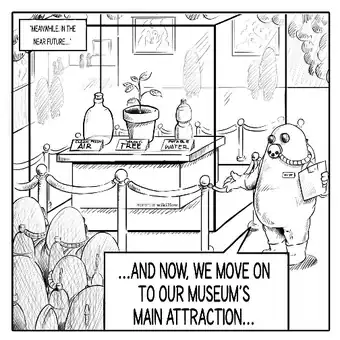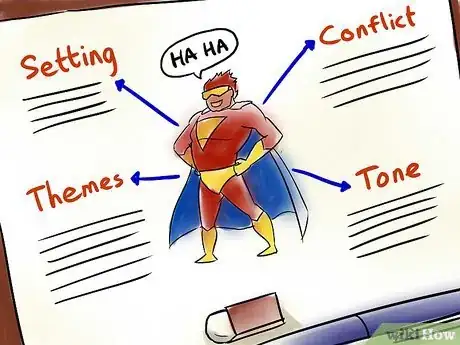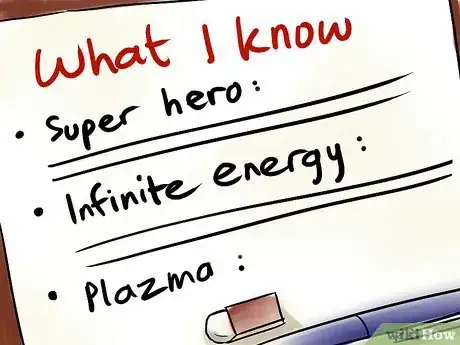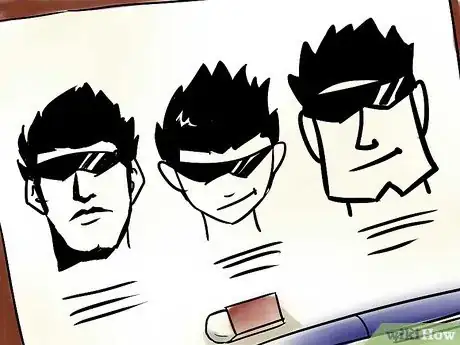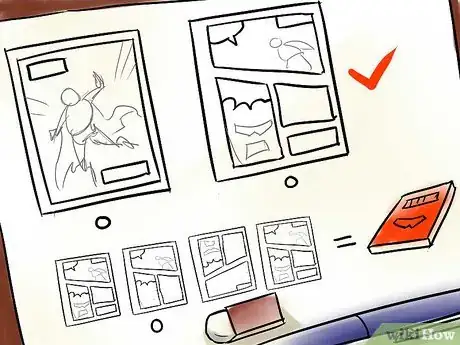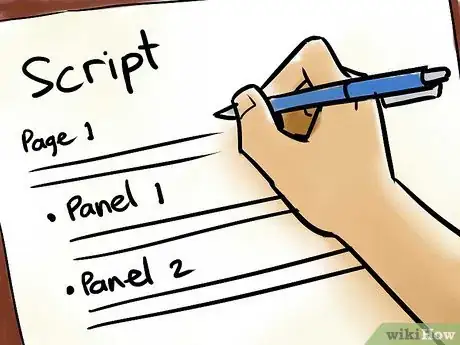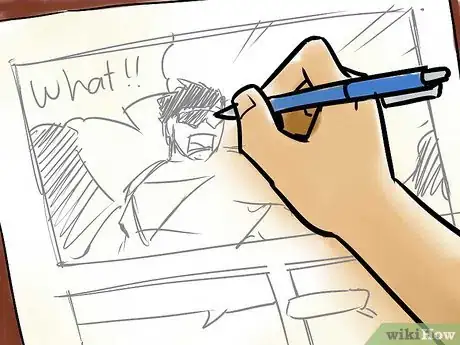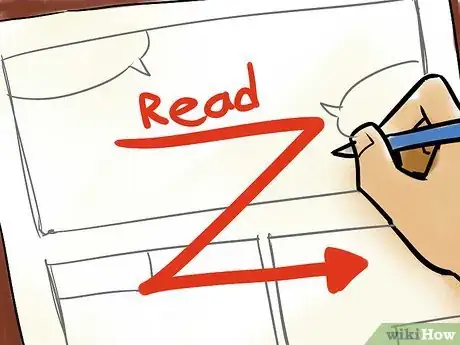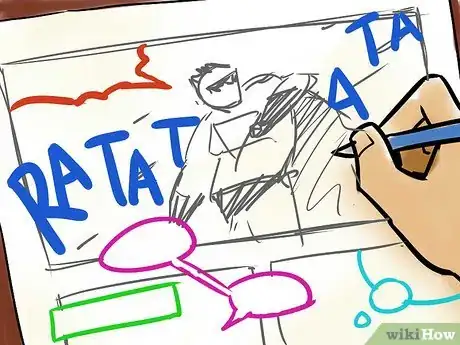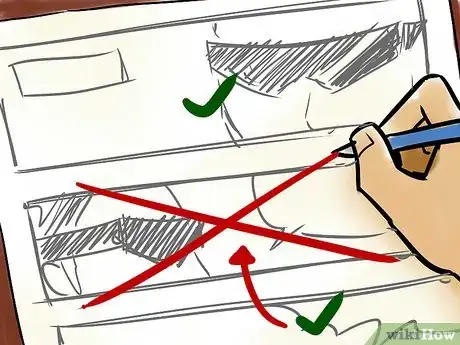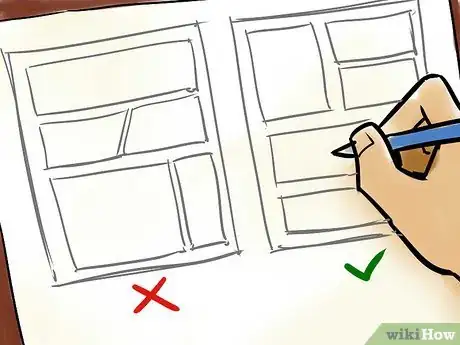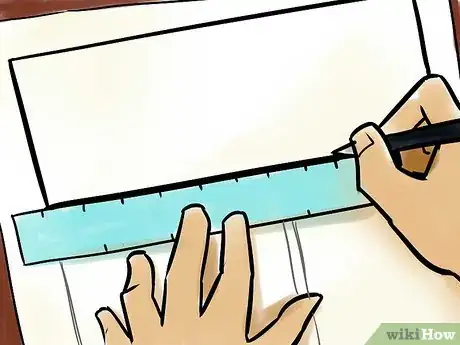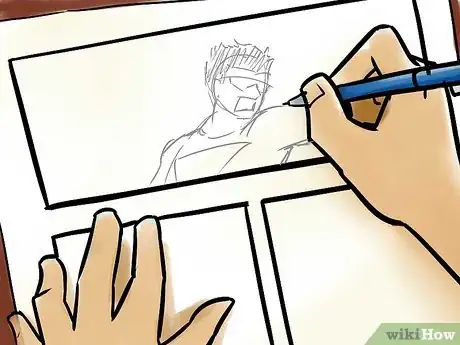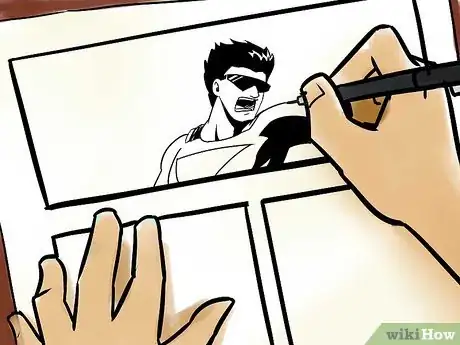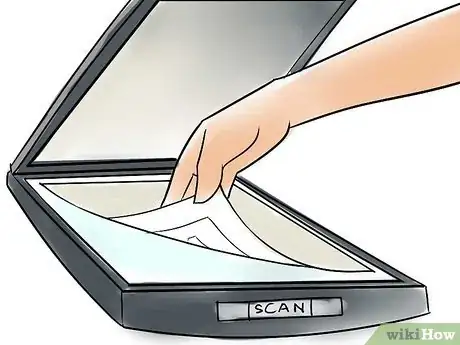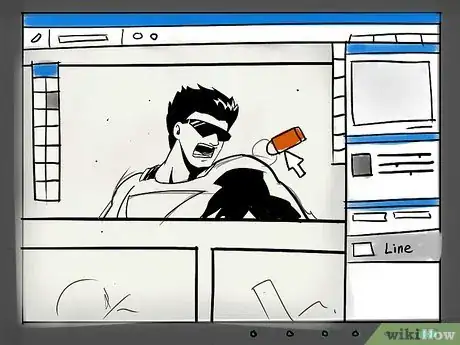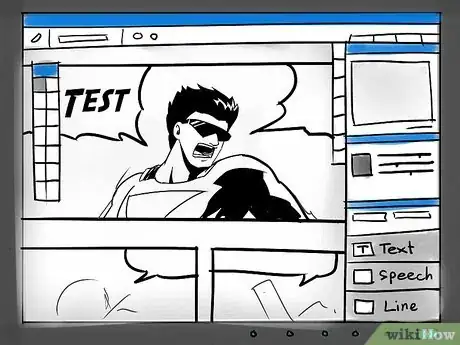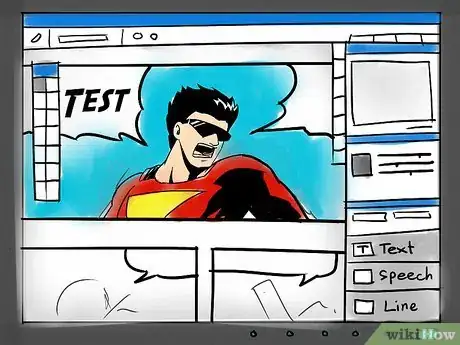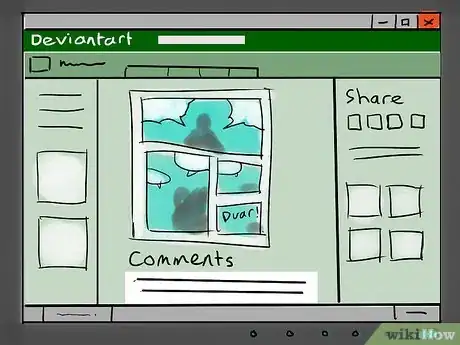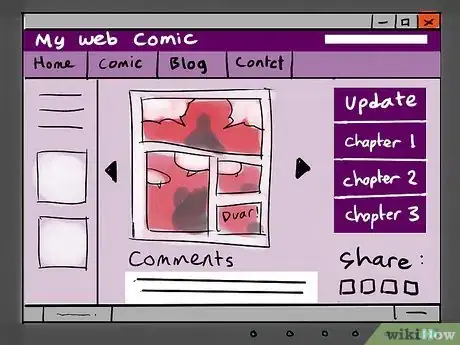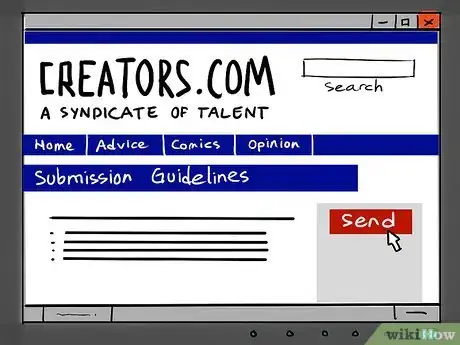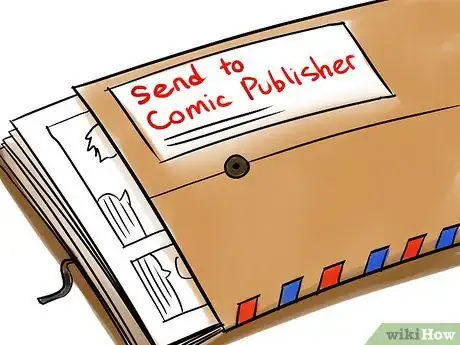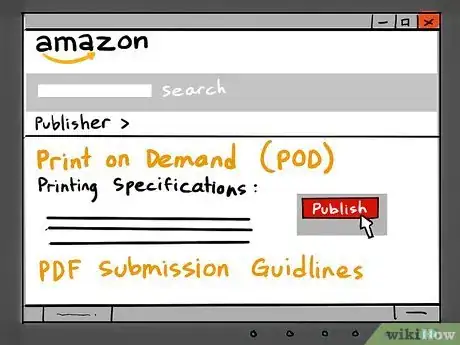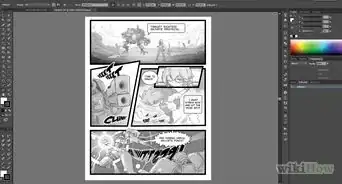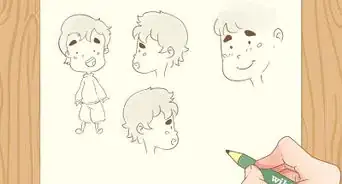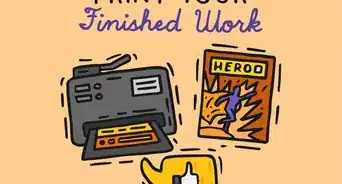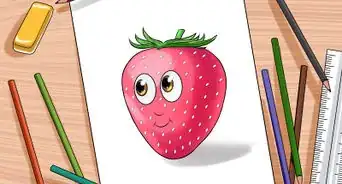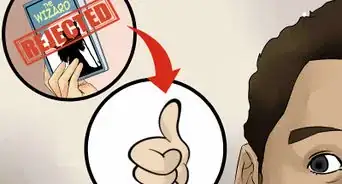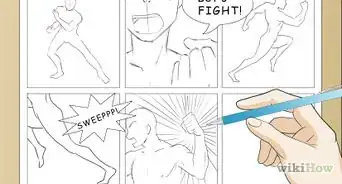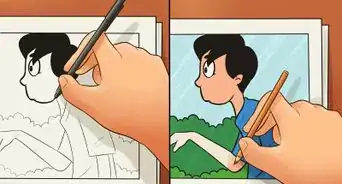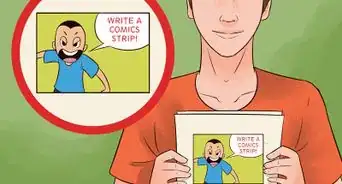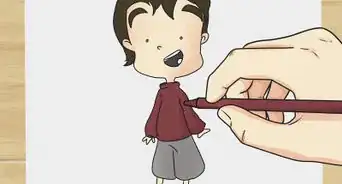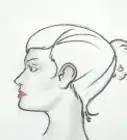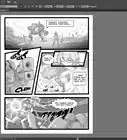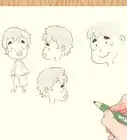This article was co-authored by Lydia Stevens. Lydia Stevens is the author of the Hellfire Series and the Ginger Davenport Escapades. She is a Developmental Editor and Writing Coach through her company "Creative Content Critiquing and Consulting." She also co-hosts a writing podcast on the craft of writing called "The REDink Writers." With over ten years of experience, she specializes in writing fantasy fiction, paranormal fiction, memoirs, and inspirational novels. Lydia holds a BA and MA in Creative Writing and English from Southern New Hampshire University.
There are 7 references cited in this article, which can be found at the bottom of the page.
wikiHow marks an article as reader-approved once it receives enough positive feedback. This article has 13 testimonials from our readers, earning it our reader-approved status.
This article has been viewed 998,041 times.
Comics have a way of making us feel. Whether that be laughter, sadness, intrigue, excitement, or any other emotion, the power of a visual story cannot be denied. Creating your own comic book can be a rewarding experience, and easier than you might think. To make a great comic, you'll need a great story, a style all your own, and a format that suits both. From there, create a rough draft before drawing, inking, and coloring the final comic itself, and publish your final masterpiece online or in print.
Steps
Sample Comics
Developing the Comic
-
1Write down the basics. A comic is, at its most basic level, a narrative told through sequential images, called frames or panels. Even a single-frame comic has to have a sense of forward movement. In that sense, a comic is not really different from any other form of storytelling, and thus follows certain conventions.
- Setting. Every story is set somewhere. Even if the background is just plain white, that’s still a setting. The setting is the backdrop for the actions of your characters, and depending on your story can be an integral part of the narrative.
- Characters. You need actors for your story. Your characters move the action, they speak the dialogue, and they are who the reader connects with. Develop your characters over time; this is especially important for strips that form longer narratives.
- Conflict. Every story needs a conflict to drive it. This is the basis of the story, the “why” of what your characters are doing. This can be as simple as checking the mail or as complex as saving the universe.
- Themes. The theme of your comic is what drives the day to day creation. Your theme will also dictate your audience. If you’re writing a comedy strip, what are the nature of the jokes? If you’re writing a love story, what are the lessons of love learned?
- Tone. This is the vibe of your comic. Are you writing a comedy? Is your story more of a drama? Maybe you’re looking at doing political cartoons. Your possibilities are endless. Combine comedy with drama, make it dark, or light-hearted. Write a romance, or a gripping political thriller.
- Your tone will be expressed through dialogue, narrative text, and visuals.
-
2Write what you know. One of the best ways to make your comics feel “true” is to write about what you know. This will also help you keep your own voice in your writing, and prevent you from copying too much from other comics.Advertisement
-
3Decide on a style. Because you are creating a comic, your visual style will be the first aspect of your comic that the reader encounters. Choose a style that matches both the tone of your story and the image you have in your head.
- Experiment with various styles until you find one that feels natural to draw and to write for. There are a variety of popular styles that you can practice and then adapt to your own needs. Here are just a few examples:
- Anime/Manga
- American Superhero
- Sprites/Clip art
- Noir
- Stick figures
- Sunday funnies
- Dramas usually necessitate a more elaborate visual style than a comedy. There are exceptions to this, however, as with every rule when it comes to creating something.
- Experiment with various styles until you find one that feels natural to draw and to write for. There are a variety of popular styles that you can practice and then adapt to your own needs. Here are just a few examples:
-
4Pick a format. There are no set conventions when it comes to format, though comics typically fall into three categories: Single frame, Strip, and Page length (comic book). Experiment with different formats until you find one that suits your story, characters, and setting.
- A single frame comic is typically reserved for comedy. These comics do not require much setup, and rely on visual gags and one or two lines of dialogue. It can be difficult to form a narrative using single frames, so most can be read in any order. Political comics are also typically one or two frames.
- A comic strip is a sequence of frames. There is no set length for a strip, though most are usually one or two lines of 2-4 frames each. This is one of the most popular formats for many webcomics and daily funnies, as they allow for narrative development but are still short enough to produce regularly.
- A comic page is a larger undertaking than a strip. Having the whole page to work with provides more freedom to manipulate frames, but also means you need more content per page. Creating full pages is typically the result of making a comic book or graphic novel, where you are telling a longer, more cohesive story.
Creating the Rough Draft
-
1Write a script. The length and detail of the script will vary depending on the style of your comic. A single frame comic may only have a line or two. Regardless, write it out to help you judge how well the story reads.
- Write your script as a sequence of frames. Treat each frame as a separate scene to help you manage the flow of the story.
- Make sure that the dialogue does not dominate the frame. Comics are a visual medium, and so a lot of your action and implied meaning will be coming through in the illustrations. Don’t let the text overpower the images.[1]
-
2Sketch out the frames. Don’t worry about accurate sizes, details, or quality. You will be creating storyboard thumbnails. Do this as you write the script. This very rough sketch will help you visualize the flow of the comic.[2]
- Focus on how characters will be placed in the frame, where the action is occurring, and how the dialogue will fit in the drawing.
- Once your thumbnails are drawn, you can try swapping their order or making adjustments to change the impact of the strip.
-
3Make sure your panel layout makes sense. The layout should guide the reader’s eyes naturally through the panels. Always remember that readers will move from left to right, top to bottom, except when reading manga which is read from right to left. Use different sizes and shapes for panels to help guide the reader.
-
4Experiment with different uses for text. Beyond dialogue, text can be used in many different ways. These include:
- Thought bubbles for a character’s inner thoughts
- Narration boxes allow a narrator to set up a scene or describe some aspect of the story.
- Sound can be displayed through the use of sound effect words.
- Exclamations can occur outside of regular speech bubbles to add extra impact.
-
5Ask yourself if every frame matters. In film, you’re never supposed to keep a scene that doesn't matter. The same is true for a comic. If the frame doesn't move the story or the comedy or the conflict forward, then cut it and either replace it with something that does or scrap it.
-
6Experiment with the frame structure. A lot of successful comics break convention when it comes to frames. If you are publishing the comic yourself, feel free to explore as many different framing options as you like. Just remember that any stylistic choices should always be in service of the story.
Drawing the Comic
-
1Create the frames. Use the ruler to draw your frames. Do this on a suitable paper. For panels that will be inserted at odd angles, or that don’t fit in the general flow, you can use separate sheets for these and then combine everything after scanning.
- If you are looking to create a comic to be published in a newspaper, the standard size is 13” x 4” for the entire comic, with four 3” frames. Newspaper strips are drawn at double the actual printed size, so the finished comic would be 6” x 1.84”. Working at double size makes it easier to draw details.[3]
- Web comics can be any size you would like, though you should keep in mind the typical viewer’s display size. If you make your comic visible on a monitor with a resolution of 1024x 768, most users will not have an issue.
- Many viewers will not enjoy scrolling left and right in a web page to view a comic. Keep this in mind when laying out the comic. Scrolling up and down is typically much more acceptable.
-
2Start adding content to your frames. Draw in light pencil so that you can easily erase and make adjustments. Continue adjusting your drawing until you have the outline for your final ink.
- Make sure to take the space needed for your dialogue into account. Leave blank space to include dialogue bubbles, thought bubbles, narration boxes, exclamations, and sound effect words.
-
3Draw your final lines. Many comic artists go over the pencil lines with ink. This allows the artist to erase the remaining pencil lines after inking is finished. Take time to make sure the final lines are polished.
- If writing dialogues by hand, add them now. Make any final revisions to the dialogue and text as you add it to the page. Chances are things will change as they make the transition from script to comic.
-
4Scan the comic. Once the inking is done, you can scan the comic onto a computer. This will allow you to add typed text as well as use image editing software to color the comic if you choose. Scanning the comic also makes publishing it online much easier.
- Scan your picture in at 600 DPI (dots per inch). This resolution will keep your drawn lines intact and crisp looking. [4]
- If your comic is too large to scan at once, scan sections of it and use the lasso tool in Photoshop to move and combine the frames back together.
- When scanning black and white images, make sure to choose the grayscale options. This is especially important for pictures with lots of shading.
-
5Clean up the image. Once you have the drawn comic scanned, you can use Photoshop to erase small mistakes or pencil lines that you may have missed. You can use Photoshop tools to add extra shading and stronger lines as well.
-
6Create your own font. One way to help your comic stand apart from others is to use a custom font. There are a wide variety of font creation programs available online, both for free and for purchase. One of the most popular is FontCreator.
- Create a font that complements the tone of the writing as well as the visual style. You can also use different fonts for different characters, though too many variations can become distracting.
-
7Add dialogue and speech bubbles in Photoshop. Use the layers tool in Photoshop to create a layer for the text and a layer for the speech bubble. Both of these layers should be separate from the layer that your drawing is on.
- Your text layer should be on top, followed by the bubble layer, followed by the original drawing on the bottom.
- Open the Blending options on the bubble layer. The Blending option will create an outline of the speech bubble at the end of the process. Select Stroke and set the following options:
- Size to 2px
- Position to Inside
- Blend Mode to Normal
- Opacity to 100%
- Fill Type to Color
- Color to Black
- Enter your text on the Text layer. This is the text that will go inside the bubble. Use the font you created above or select a font appropriate for your visual style. Comic Sans is a popular font.
- Select the bubble layer. Use the Elliptical Marquee tool to create a selection bubble around the text that you wrote. Place the cursor in the center of the text, and hold the Alt key while dragging the mouse in order to create an elliptical selection bubble that is evenly placed over the text.
- Select the Polygonal Lasso tool, and hold the Shift key while clicking to create a sharp triangle tail in the selection.
- Select White as your foreground fill color.
- Press Alt + del to fill the selection on the bubble layer. The outline will automatically be created when this happens, and the speech bubble is complete.
-
8Color your comic. This is optional, as many successful comics are printed in black and white. There are a couple of options when coloring comics. You can color directly onto the page, using physical coloring tools, or you can color digitally after scanning the comic into a computer.
- More and more comics are being colored through digital means. Programs like Illustrator and Photoshop make the coloring process much less tedious than in the past.
- Remember that the reader will see both the entire comic and individual frames at the same time. Try to keep a cohesive color palette throughout your comic to keep frames from being distracting.
- Use a color wheel to make sure that the colors you pick work together harmoniously. A color wheel helps when confronted with the millions of colors available on modern computers.
- Colors opposite of each other on the color wheel are complementary. These colors are high contrast, and should be used in small amounts to avoid becoming overbearing.
- Analogous colors are located next to each other on the color wheel. These are typically very pleasing sets of colors to the eye.
- Triadic colors are three colors evenly spaced around the wheel. Typically you would use one color as the dominant color, and use the other two for accents.[5]
Publishing Your Comic
-
1Upload to an image host and spread the links. If you just want to share your comic with some friends and family, uploading it to an image host will be the cheapest (free) and easiest way to do it. Create an account with a service like PhotoBucket, ImageShack, or imgur and upload your creation.
- Send the links to whoever you want, post them on your social network feeds, tweet the URL to anyone who will read it. Find comic enthusiast forums and post your links for people all over the world to see.
-
2Create a DeviantArt account. DeviantArt is one of the most popular places online for posting art. They have an entire section devoted to cartoons and comics. When you post your images, fans can leave comments, giving you a chance to interact with your audience.
- Interacting with other artists on DeviantArt can give you new ideas and perspectives on your own creations.
-
3Create your own web comic page. If you feel like you have enough content to share with the world, start your own web comic page. This is the best way to grow an audience for your work without having to go through traditional publishing channels. It will require more time and dedication than simply using an image hosting service, but the benefits are far greater.
- Create a website that looks good. If the website does not function properly and does not match the aesthetic of your comic, you will drive users away. Take some time and look at how successful web comics have integrated the style of the comic into the website design.
- Have your website designed professionally. This can be cheaper than you think, especially if you enlist the aid of up-and-coming designers. Use resources such as DeviantArt to find a like-minded person who will help you design your web comic page.
- Update often. The point of a web comic is to keep people coming back. Set a regular update schedule for yourself. If readers know when to expect the next release, they will often come back even without you advertising it.
- Interact with your readers. Beyond simply updating the page with new comics, take some time and write blog entries and respond to reader comments. This will help advertise you as the creator and form strong bonds between you and your audience.
-
4Send it to a syndicate. If you feel like your strip would be a good fit for newspapers, talk to a syndicate. These are publishing groups that sell their comics to papers around the world. Syndicates receive thousands of submissions every year, and typically only pick about 3-4 strips.[6] The major comic syndicates are:
- Creators Syndicate
- King Features Syndicate
- Washington Post Writers Group
- Tribune Media Services
- United Feature Syndicate
-
5Send it to a publisher. If you have a non-newspaper strip or comic, you may want to consider sending it to traditional comic publishers. The comic publishing industry has expanded significantly over the last few decades, and now includes all manner of graphic novels and comic collections. Note that DC and Marvel do not take unsolicited submissions. You will need to make a name for yourself elsewhere first. Some major publishers:
- DC Comics
- Image Comics
- Dark Horse
- Beyond the major publishers, there are numerous independent publishers that are always looking for new submissions.
-
6Self publish your comic. As tools for self publishing become more widespread, the ease of publishing material has greatly increased. Resources such as Amazon’s CreateSpace allow authors to easily. CreateSpace will automatically list your comic on Amazon, and will print copies to match orders. This takes a lot of the manufacturing and distributing work off of your shoulders.
- If you want to improve your writing style or expand the type of styles you can write in, start with reading. It is important because it helps to know the styles of different people. For example, you can note what they did with their dialogue or setting.[7]
- Take writing classes and listen to podcasts. They will help to improve your writing style.[8]
- Attend workshops. There are countless workshops for writers. You can also join writing groups and associations.[9]
Community Q&A
-
QuestionIs it okay to color with crayons?
 ThesmartpotatoCommunity AnswerIf you're planning on scanning it, no. Crayons can leave some chunky parts in the place you colored, which would look strange in a scanned comic.
ThesmartpotatoCommunity AnswerIf you're planning on scanning it, no. Crayons can leave some chunky parts in the place you colored, which would look strange in a scanned comic. -
QuestionCan I design my own comic on a computer rather than drawing it on paper?
 Community AnswerOf course; plenty of artists work almost exclusively on their computers.
Community AnswerOf course; plenty of artists work almost exclusively on their computers. -
QuestionWhat if I feel uncomfortable about sending it?
 Community AnswerMany writers and artists are very nervous about facing the rejection and criticism of their work; it's the equivalent of a singer performing in front of a large audience. If you don't feel it's ready, set it aside for a month or two and don't look at it; when you pull it back out and review, you'll have a bit of distance from it and mistakes stand out much better. If you feel that it represents your best efforts, step outside of your comfort zone and submit it. Know that regardless of how good your work is, there are always going to be people who don't like it; however, your critics will be the most vocal about your weak points, guiding you toward areas you can improve. In short, though, you undoubtedly created your comic because it's a passion, and the only person whose opinion about it that matters is yours.
Community AnswerMany writers and artists are very nervous about facing the rejection and criticism of their work; it's the equivalent of a singer performing in front of a large audience. If you don't feel it's ready, set it aside for a month or two and don't look at it; when you pull it back out and review, you'll have a bit of distance from it and mistakes stand out much better. If you feel that it represents your best efforts, step outside of your comfort zone and submit it. Know that regardless of how good your work is, there are always going to be people who don't like it; however, your critics will be the most vocal about your weak points, guiding you toward areas you can improve. In short, though, you undoubtedly created your comic because it's a passion, and the only person whose opinion about it that matters is yours.
Warnings
- Sometimes it will take a while until your comic gets noticed, don't give up too quickly!⧼thumbs_response⧽
- Be careful not to copy another person's idea directly! It's one thing to be inspired by other comics, but those ideas belong to those who made it. Be creative, and come up with your own!⧼thumbs_response⧽
References
- ↑ http://www.creativecomicart.com/comic-panels--layout.html
- ↑ http://www.lackadaisycats.com/makingacomic.php
- ↑ http://kingfeatures.com/contact-us/submission-guidelines/
- ↑ http://forums.questionablecontent.net/index.php?topic=18336.0
- ↑ http://www.tigercolor.com/color-lab/color-theory/color-theory-intro.htm
- ↑ http://www.comicsreporter.com/index.php/all_about_comics/all_about/76/
- ↑ https://www.wordstream.com/blog/ws/2014/08/07/improve-writing-skills
- ↑ https://www.wordstream.com/blog/ws/2014/08/07/improve-writing-skills
- ↑ https://www.wordstream.com/blog/ws/2014/08/07/improve-writing-skills
About This Article
To make a comic, use a ruler to draw the frames that will contain the action. Lightly draw your characters into each frame with a pencil, leaving plenty of blank space for dialogue bubbles, narration boxes, exclamations, and background details. If you like, go over the pencil lines with ink once you are satisfied with the layout. If you’re writing in the text by hand, do it now, otherwise, scan in the comic at 600 DPI and add any typed text or image editing software to make final changes. To learn about popular comic styles and formats, keep reading!


